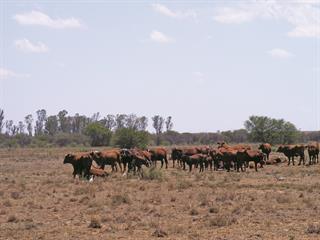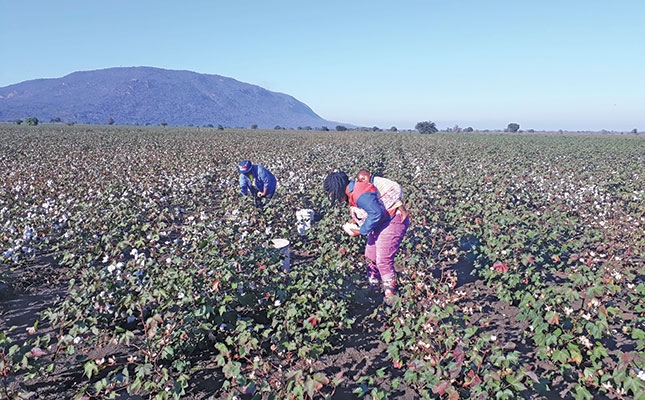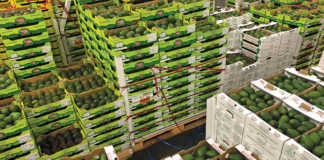
Photo: Annelie Coleman
In extensive areas of the central interior, very little grazing is currently available. With soil water levels down, the prospects for grass regrowth are not good. Conditions that have a severe impact on the production engines of soil and plants will naturally affect veld production and livestock equally badly. We will look at how your livestock can survive a drought.
Grain stover, generally used to overwinter livestock, will not be readily available this coming season because of poor performance, and in some cases outright failure, of grain crops. While the prospects for livestock production do not look good, all is not lost as most farmers have the management skills to navigate the drought.
The following guidelines may help producers prevent mortalities and reduce financial loss:
- Ensure that cash flow is maintained judiciously.
- Safeguard core breeding herds and flocks, and remember that these animals are the post-drought income generators.
- Where possible, provide strategic supplementary feeding on veld.
- Reduce the number of animals dependent on natural feed sources by selling surplus stock, or by temporarily moving animals from the veld to a kraal or planted pasture.
- Restrict livestock movement by confining animals to small paddocks with shade trees, or some form of field shelter. It helps the stock manager maintain better control over the daily feed-out.
- Make sure that all animals have free access to clean drinking water.
- Separate stronger and weaker animals to reduce competition at the feed troughs.
- Do not feed animals ad lib over a long period. Ration the feed according to the required production levels – for example, survival, body mass maintenance or lactation.
- Do not waste feed by throwing it on the ground; use appropriate feed troughs or conveyor belts.
- Provide the rationed feeds every second or third day. Most animals will receive enough feed in this way, and competition will be reduced at the feed troughs.
The base feed for ruminants is roughage, be it on the veld or in the trough. The coarser the roughage is ground, the less the waste. Energy content can be increased with, for example, ground maize, and balanced with an appropriate crude protein. Mineral intakes must also be balanced according to animals’ requirements. Restrict the daily salt intake (NaCl) for sheep to between 5g and 10g and for cattle to between 50g and 60g.
Hold onto the breeding core to survive a drought
Animals should be grouped according to age and production status. After cows have been bred, check for in-calf status as soon as possible. Sheep and goats can be scanned to check for twins or triplets, and their nutrition levels adjusted accordingly.
The condition of teeth must also be assessed, especially in older females. Cows in calf should be able to graze until the next calving and must be able to wean the unborn calf. Females with worn teeth can complete their production cycle in a kraal, but this will come at a price.
It’s a good idea for farmers to make an inventory of available veld and all alternative feed sources. This information provides the farmer with a useful tool to work out his carrying capacity into the next summer. Reduce the number of animals dependent on feed sources by marketing surplus stock or by temporarily removing them from the veld, so that your livestock can survive a drought.
Check the breeding records and note progeny weaning mass. Cull the least productive animals in each age class. The principle of ‘cutting your losses’ applies here, and all expenses must be weighed and discounted against expected short- to medium-term income.
Source and resource
When grazing is scarce, licks will not help. It is better to take the animals off the veld and put them into small camps where it is easier to strategise a feeding programme. Grass growing on verges can be cut and baled. The cladodes of spineless cactus pears can also be used as feed – whole cladodes for cattle and coarsely chopped material for sheep and goats.
During a drought, feed quality has to become a secondary issue. Clearly, there cannot be too much fuss about feed quality in a life-and-death situation. If poor quality roughage such as veld grass hay, crop residues or cactus pear cladodes is available, animal nutritionists can use it as a basis to formulate diets that meet the minimum requirements of livestock.
The veld at this stage contains little crude protein. The ruminant digestive system, and its symbiosis with microbes in the reticulo-rumen, offers an opportunity to supplement crude protein with a non-protein nitrogen (NPN) source such as feed-grade urea.
The microbes break down cellulose (fibre) to produce nutrients (volatile fatty acids and microbial protein). The complex four-compartment ‘stomach’ develops gradually from the suckling phase (basically still monogastric) to that of a physiologically mature ruminant.
In younger calves and lambs/kids the reticulo-rumen is still developing. Therefore it is better to use natural, higher-quality protein in young animals instead of NPN; bypass protein may also be supplied strategically.
Supplements and inoculation so that your livestock can survive a drought.
Producers should be clear on the objective of supplemental feed. Animal health starts at the mouth and good nutrition is the basis of good production.
Managers may need to adjust their inoculation programmes for improved immunity during times when drastic changes are made because of the added stress this puts on the immune system. Discuss any possible changes in the animal health and disease control programme with the herd vet and keep dosing programmes up to date.
Obtain advice from an animal nutritionist about various options and products. A range of products is available. There is no point in feeding animals on the veld with no real aim. Body condition will drop and moderate body mass loss of between 10% and 15% is acceptable. But this should take place in a managed and controlled environment and over a relatively extended period.
Email Prof HO de Waal at [email protected]













